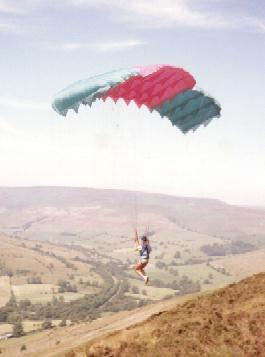About Flying...
At the moment this section of the website is a single page, however we plan to extend this as soon as possible to cover flight theory and other articles of a coaching nature.
What is Paragliding?

Paragliding started when some parachutists took their rigs to a hill with the wind blowing onto it to practise canopy control. They found that if the wind was perfect they could soar the hill. However if there was too little wind they couldn't stay up, too much and they went backwards. At about the same time people were jumping off the Alpine peaks with square jump chutes. It was soon realised that if the performance could be improved then maybe this could be a real sport in it's own right. The parachutes were developed into longer and thinner wings to become today's performance gliders which can travel great distances, with the right pilot. Paragliders differ from the original ram air parachutes in that they are made of material that will not let air through (non-porous), this is one of the reasons why you couldn't free fall with a paraglider as it would literally explode on opening. The development continues apace with various designers looking for that little something that will make their new glider that little bit better than everyone else's. However, there has been a move to remove the extreme prototypes from flying competitions to reduce the number of accidents.
A paraglider works by using its forward speed to inflate the wing which has an aerofoil section. The wing inflates as air flows into the cell openings at the front but can't escape at the back. The wing thus created behaves like any other aerofoil wing. Because any glider is un powered it is always falling, a good paraglider will fall at about 1 metre a second. If the pilot can find and fly in air that is rising at the same rate or higher he will be able to stay aloft. Although the glider is still falling through the air the whole mass that it is contained in is rising so the glider will rise with respect to the ground. A good pilot needs to understand where he is likely to find lifting air to stay in that air.
So What Is Hang Gliding?
Hang Gliders fly using similar principles to paragliders. The main difference is that the hang glider has a semi rigid frame over which the sail clot is stretched to form the aerofoil section. Hang gliders are faster and probably more like flying a 'real' aircraft. However it takes longer to set them up (rig them) and they are more demanding (at least initially) to fly. Many people now fly both wings. The latest developments in hang gliding have seen slower easier to fly models being introduced and also gliders with control surfaces that look like foot launched sailplanes and indeed are starting to come close on performance.
How do I learn to Hang Glide or Paraglide?
You can't just go out and buy a glider and teach yourself - although some people undoubtedly have, it can't be recommended. You could hurt yourself - or worse you could hurt someone else. By the far the best method is to sign yourself up with a recognised school. Both hang gliding and paragliding follow a similar syllabus. You will first aim for your Elementary Pilot, which takes about 4 flyable days. Some people stop here having got that piece of paper. If, however, you have got the flying bug you will need to go on to get your Club Pilot. This will take a similar amount of time, and is also where the hang gliding syllabus varies slightly from the paragliding one in that 2 of the final tasks can be done in your flying club. All the various pilot qualifications involve a multiple choice exam, with the exception of the Advanced Pilot.
Local Schools
Click here to find the Local Schools listed on our Links page.

